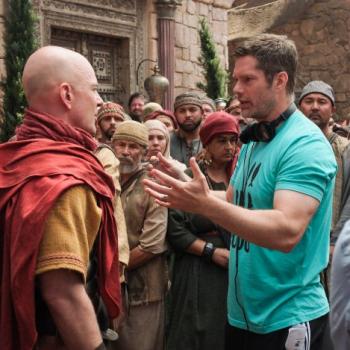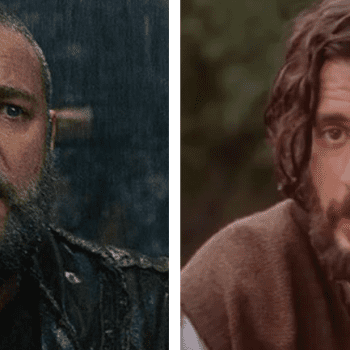Season 1, Episode 2 — ‘The Body Is Gone’
Matthew 28, Luke 24, John 20-21, Acts 1
Harmonization, redux. It’s pretty much impossible to harmonize the empty-tomb accounts in the four canonical gospels, and A.D. The Bible Continues doesn’t even try. It does, however, blend the various resurrection appearances that took place afterwards, as well as the final words of Jesus in Matthew and Acts.
For the discovery of the empty tomb itself, the series follows the basic template set by John’s gospel: Mary Magdalene goes to the tomb by herself,1 finds it empty, comes back and tells Peter and John, goes back to the tomb with them, and then encounters Jesus by the tomb after Peter and John have gone back to the city.
However, in this episode she does not see the angels that John mentions, after Peter and John have gone back to the city and before she sees Jesus. (In Luke’s gospel, she and the other women see these angels before Peter goes to the tomb.)
After that, the resurrection appearances are a mix of things, source-wise.
Jesus appears to most of the disciples in the upper room and eats a piece of bread to prove that he has a physical body (in Luke’s gospel, he eats a piece of fish instead), but Thomas is missing on this occasion, so Jesus appears to the apostles in the upper room again after Thomas has rejoined them (as per John’s gospel).
Then, the apostles go to Galilee and encounter Jesus while fishing (as per John’s gospel), and afterwards he walks up a mountain with them and tells them to spread his message (as per Matthew’s gospel), and then, after that, he ascends into heaven (in both Luke and Acts, this happens outside Jerusalem and not in Galilee).
The episode does not depict Jesus’ appearance to Peter before he appeared to the others (as per Paul and Luke), nor does it depict his appearance to Cleopas and the other person walking to Emmaus on the day of the Resurrection itself.
It’s interesting that this episode omits the women who accompanied Mary Magdalene to the tomb (as per Mark, Matthew and Luke) and encountered the risen Jesus with her before the male disciples did (as per Matthew’s gospel), since we know that A.D. will eventually introduce one of those women, namely Joanna. Oh well.
Pacing. The book of Acts tells us that Jesus ascended to heaven forty days after he rose from the dead, so unlike the first episode of A.D., which covered a single weekend, this second episode should be covering a month and then some. But it feels like it is covering a much, much smaller span of time than that.
Consider: In John’s gospel, an entire week passes between Jesus’ appearance to the disciples without Thomas and his subsequent appearance to the disciples with Thomas. But here it all seems to happen in a single day. (Thomas leaves the upper room to check the empty tomb for himself, but he comes back and says the temple guards are already re-sealing it, to put an end to the resurrection rumours.)
Consider also how the disciples are shown fleeing Jerusalem under cover of a riot in one scene, and are then shown fishing in Galilee the next time we see them. The latter scene is so relaxed compared to all the action that precedes it, it doesn’t really fit.
How did the disciples shift gears like this? What was the journey from Jerusalem to Galilee like? (Google Maps says it takes at least two days by foot.) How long did Peter and the others mill about, wondering what to make of the things they had seen in Jerusalem, before they decided to go back to their old job? Whose boat are they using? We know that we will see Peter’s daughter in future episodes, so where is she while these scenes in Galilee are happening? The episode never fills in those blanks.
In this respect, the second episode feels like a step down from the first, which used the time between the crucifixion and the resurrection to develop the disciples and explore how they felt. There’s a bit of that at the beginning of the second episode, after Mary Magdalene discovers the empty tomb, but after that it’s all plot, plot, plot.
Scripture references, redux. Once again, Caiaphas quotes the Old Testament in his prayers. The first part of the prayer he speaks before sinking into his mikvah comes from Jeremiah 17. I am not sure where the second part comes from.
The “warrior angels” at the Ascension have no direct basis in the book of Acts, but they do have something to do with it in a roundabout sort of way.
The book of Acts simply says that Jesus rose into the air and vanished behind a cloud, and that two men dressed in white suddenly appeared next to the disciples and told them that Jesus would return one day the same way they had seen him leave.
There is no rising through the air in this episode, and there are no angels talking to the apostles either. But in last week’s episode of Beyond A.D., Mark Burnett revealed that the “warrior angels” were added to this scene to foreshadow the Second Coming.
There are numerous passages in the New Testament that describe Jesus or “the Son of Man” coming back to Earth accompanied by “clouds” and “angels”. In John’s gospel, Jesus tells the apostles that they “will see heaven open, and the angels of God ascending and descending on the Son of Man,” while Paul writes in II Thessalonians that Jesus will be “revealed from heaven in blazing fire with his powerful angels.” Those passages seem to have had the most direct influence on this scene.
So, because the angels in Acts told the disciples that Jesus would come back the way he left, and because these other passages seem to describe the Second Coming a certain way (though some scholars, such as N.T. Wright, argue that at least some of those passages are actually describing something else), this episode depicts the Ascension that way instead of giving us a more literal depiction of Acts 1.
Incidentally, last year I devoted an entire post to depictions of the Ascension in film, and I noted that very, very few films have depicted it the way Acts describes it.
Many films have avoided the Ascension altogether, and those that do depict it have tended to do so indirectly, by using overlapping images or having Jesus vanish off-screen. This is partly to avoid anything as potentially goofy as the sight of a flying Jesus (especially if the visual effects aren’t up to snuff), and also partly to convey the notion that Jesus has transcended the literal historical setting of the story.
A.D., for all its spectacle, similarly avoids depicting the Ascension directly. It never actually shows Jesus ascending into heaven. Instead, as Jesus walks up the mountain, a giant cloud comes down to Earth and a light opens where the cloud and mountain meet, as if Jesus is about to step into some sort of inter-dimensional portal.
Violence. Reuben, the head of the temple guard, hires a guy to find a dead body — and possibly murder it himself — so that the priests can wound it and pass it off as the body of Jesus, though Caiaphas nixes this idea as soon as he sees the corpse.
Cornelius — the centurion described in Acts 10 as devout, prayerful, and generous to the poor even before he becomes a Christian — threatens to hit Mary Magdalene while he looks for Jesus’ body, though he does not actually hit her in the end.
Two of the Romans chasing the disciples through the streets of Jerusalem run into a house filled with Jewish men who immediately begin beating the Romans up.
Cornelius puts the city of Jerusalem under “lockdown” — a rather modern-sounding word, to my ears — so the Zealots team up with the disciples to get them out of the city. The Zealots throw rocks and the first-century equivalent of Molotov cocktails at the Romans by the gate, and in all the commotion, the disciples get through.
(Before this, there is some pro forma dialogue between Peter and Boaz, the Zealot, to clarify that Peter disapproves of violence; Boaz, for his part, says he only takes life as a last resort. Once again, there is no acknowledgement of the fact that, in the Bible, Peter had cut off the ear of the high priest’s servant just a few days earlier.)
The guards who were stationed at the tomb all suffer horrible deaths at the hands of the Romans. The Jewish guards are murdered in the street by Cornelius, and the Roman guards are first beaten by their colleagues in one scene, and then strangled to death in another, except for one who is stabbed in the back by Pilate himself.
Family matters, redux. Caiaphas’s wife does a lot of proclaiming in this episode, as she did in the first one. She spends a lot of time describing people to themselves or articulating theories about the nature of good leadership, etc. I do appreciate the scene where she and Caiaphas almost kiss, but of course, alas, they are interrupted.
I also appreciate Pilate’s concern for his own wife’s mental well-being. She’s perfectly fine, of course. But Pilate doesn’t accept her dreams and premonitions, and it’s interesting to see him react to this side of her with something resembling weary concern, instead of the outrage that he vents at Caiaphas and the Roman soldiers.
Political friction, redux. Caiaphas barged in on Pilate’s office last week. Now this week, Pilate and his officers barge in on Caiaphas while he is bathing in a mikvah.
Apologetics, redux. As Caiaphas interrogates the Jewish guards, he emphasizes that the stone at the tomb was so heavy it must have taken multiple men to roll it away. Similarly, Simon the Zealot asks Thomas how all of the apostles could have been deluded into thinking that they had seen Jesus the same way at the same time.
Lines like these sound like the sort of points that many an apologist has made over the years. Most Jesus films don’t spell things out quite so clearly; the disciples who have seen Jesus believe in his resurrection, and those who haven’t don’t, but they rarely try to convince each other of their doubt or belief through logical argument.
Theological points, redux. When Thomas sees Jesus, he says, “My Lord,” and that’s it. In John’s gospel, he says “My Lord, and my God,” to underscore the recurring theme of John’s gospel that Jesus is divine in every sense of the word.
In the 1985 miniseries A.D. Anno Domini, Thomas says, “My master, and my Lord.”
Perhaps, for most English-speaking viewers, the word “Lord” is now associated more often with divinity than with a higher social class: thus, the 1985 miniseries shifted the language (replacing “lord” with “master” and “God” with “Lord”), while the current series perhaps did not omit the word “God” so much as conflate it with “Lord”.
The same, but different, redux. Pilate’s wife Claudia says Jesus was “favoured by the gods,” which is similar to what she said (“chosen by the gods”) in The Bible.
Odds and ends. Jesus closes his eyes when eating the bread in the upper room as if to indicate the pleasure it gives him. You can almost hear him thinking, “I haven’t had anything to eat in so long…” It’s actually kind of reminiscent of movies like The Preacher’s Wife and Meet Joe Black, in which an angel or similar spiritual being assumes a human form and takes great delight in the ability to eat food.
–
1. Interestingly, while Mary Magdalene seems to be the only woman who finds the empty tomb in John’s gospel, John does record that Mary said, “They have taken the Lord out of the tomb, and we don’t know where they have put him,” which suggests that there may have been other people with her on that first trip to the tomb who are simply never mentioned by John. This would fit with the other three gospels, which all say that other women went to the tomb with Mary Magdalene.
–
CT Movies recaps: one | two | three | four | five | six | seven | eight | nine | ten | eleven | twelve
FilmChat recaps: one | two | three | four | five | six | seven | eight | nine | ten | eleven | twelve













